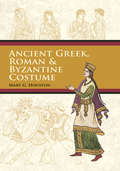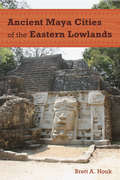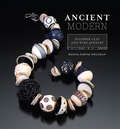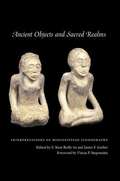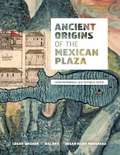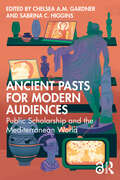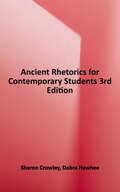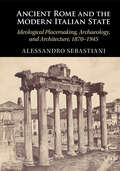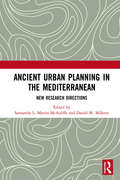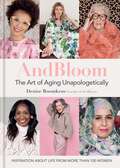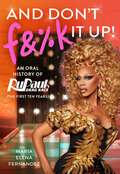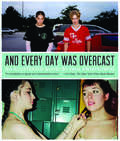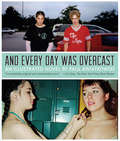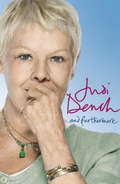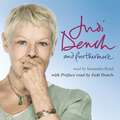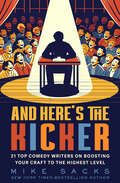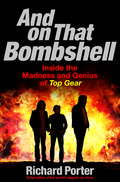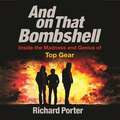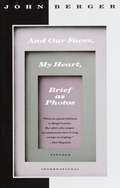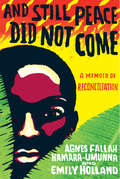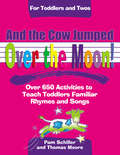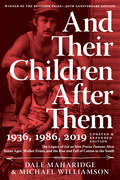- Table View
- List View
Ancient Greek, Roman & Byzantine Costume
by Mary G. HoustonThis scrupulously researched and abundantly illustrated book includes 315 drawings based on renderings by artists of the period to achieve utmost accuracy and authenticity.Included are elaborate examples of Aegean costume, Doric and Ionic styles of dress for women, Greek and Roman armor, graceful and intricately arranged Roman togas, the tunica — roomy, wide-sleeved apparel; and the pallium, a cloak-like garment. Ornate vestments of the Eastern Orthodox Church and Byzantine costumes are carefully described and portrayed, as are styles of hairdressing, jewelry, and other decorative elements.An excellent reference for the history classroom, the volume also includes instructions and flat patterns showing the cut of sample garments, making it easy for costume designers to reproduce period apparel. This book will be valuable as well to costume historians and art students interested in the development of representative art.
Ancient Maya Cities of the Eastern Lowlands (Ancient Cities of the New World)
by Brett A. Houk"Brings together for the first time all the major sites of this part of the Maya world and helps us understand how the ancient Maya planned and built their beautiful cities. It will become both a handbook and a source of ideas for other archaeologists for years to come."--George J. Bey III, coeditor of Pottery Economics in Mesoamerica "Skillfully integrates the social histories of urban development."--Vernon L. Scarborough, author of The Flow of Power: Ancient Water Systems and Landscapes "Any scholar interested in urban planning and the built environment will find this book engaging and useful."--Lisa J. Lucero, author of Water and Ritual For more than a century researchers have studied Maya ruins, and sites like Tikal, Palenque, Copán, and Chichén Itzá have shaped our understanding of the Maya. Yet cities of the eastern lowlands of Belize, an area that was home to a rich urban tradition that persisted and evolved for almost 2,000 years, are treated as peripheral to these great Classic period sites. The hot and humid climate and dense forests are inhospitable and make preservation of the ruins difficult, but this oft-ignored area reveals much about Maya urbanism and culture. Using data collected from different sites throughout the lowlands, including the Vaca Plateau and the Belize River Valley, Brett Houk presents the first synthesis of these unique ruins and discusses methods for mapping and excavating them. Considering the sites through the analytical lenses of the built environment and ancient urban planning, Houk vividly reconstructs their political history, considers how they fit into the larger political landscape of the Classic Maya, and examines what they tell us about Maya city building.
Ancient Modern: Polymer Clay And Wire Jewelry
by Ronna WeltmanWith Ancient Modern, learn to create organic, sophisticated, and distinctly contemporary jewelry by artistically combining polymer clay and wire.Use a range of innovative techniques to design beads and jewelry components from polymer clay.Add wireworking elements, inspired clasps and ear wires, and more for a signature look.16 one-of-a-kind projects, including necklaces, bracelets, and pins in Ronna's distinctive style.Each project features detailed instructions and step-by-step photography.Crafters and jewelry makers will be making gallery-style jewelry in no time!In addition to an extensive technique section on polymer clay, wireworking, and jewelry design, readers will also find a gallery of work for endless inspiration.Ancient Modern draws on artist Ronna Sarvas Weltman's fundamentals of jewelry design, what makes a piece "primitive," and shows how to achieve her organic effects and signature style, from color mixing to texture effects.
Ancient Mythological Images and Their Interpretation
by Katharina LorenzWhen we try to make sense of pictures, what do we gain when we use a particular method - and what might we be missing or even losing? Empirical experimentation on three types of mythological imagery - a Classical Greek pot, a frieze from Hellenistic Pergamon and a second-century CE Roman sarcophagus - enables Katharina Lorenz to demonstrate how theoretical approaches to images (specifically, iconology, semiotics, and image studies) impact the meanings we elicit from Greek and Roman art. A guide to Classical images of myth, and also a critical history of Classical archaeology's attempts to give meaning to pictures, this book establishes a dialogue with the wider field of art history and proposes a new framework for the study of ancient visual culture. It will be essential reading not just for students of classical art history and archaeology, but for anyone interested in the possibilities - and the history - of studying visual culture.
Ancient Objects and Sacred Realms: Interpretations of Mississippian Iconography
by James F. Garber F. Kent Reilly IIIBetween AD 900-1600, the native peoples of the Mississippi River Valley and other areas of the Eastern Woodlands of the United States conceived and executed one of the greatest artistic traditions of the Precolumbian Americas. Created in the media of copper, shell, stone, clay, and wood, and incised or carved with a complex set of symbols and motifs, this seven-hundred-year-old artistic tradition functioned within a multiethnic landscape centered on communities dominated by earthen mounds and plazas. Previous researchers have referred to this material as the Southeastern Ceremonial Complex (SECC). This groundbreaking volume brings together ten essays by leading anthropologists, archaeologists, and art historians, who analyze the iconography of Mississippian art in order to reconstruct the ritual activities, cosmological vision, and ideology of these ancient precursors to several groups of contemporary Native Americans. Significantly, the authors correlate archaeological, ethnographic, and art historical data that illustrate the stylistic differences within Mississippian art as well as the numerous changes that occur through time. The research also demonstrates the inadequacy of the SECC label, since Mississippian art is not limited to the Southeast and reflects stylistic changes over time among several linked but distinct religious traditions. The term Mississippian Iconographic Interaction Sphere (MIIS) more adequately describes the corpus of this Mississippian art. Most important, the authors illustrate the overarching nature of the ancient Native American religious system, as a creation unique to the native American cultures of the eastern United States.
Ancient Origins of the Mexican Plaza: From Primordial Sea to Public Space
by Logan Wagner Hal Box Susan Kline MoreheadThe plaza has been a defining feature of Mexican urban architecture and culture for at least 4,000 years. Ancient Mesoamericans conducted most of their communal life in outdoor public spaces, and today the plaza is still the public living room in every Mexican neighborhood, town, and city-the place where friends meet, news is shared, and personal and communal rituals and celebrations happen. The site of a community's most important architecture-church, government buildings, and marketplace-the plaza is both sacred and secular space and thus the very heart of the community. This extensively illustrated book traces the evolution of the Mexican plaza from Mesoamerican sacred space to modern public gathering place. The authors led teams of volunteers who measured and documented nearly one hundred traditional Mexican town centers. The resulting plans reveal the layers of Mesoamerican and European history that underlie the contemporary plaza. The authors describe how Mesoamericans designed their ceremonial centers as embodiments of creation myths-the plaza as the primordial sea from which the earth emerged. They discuss how Europeans, even though they sought to eradicate native culture, actually preserved it as they overlaid the Mesoamerican sacred plaza with the Renaissance urban concept of an orthogonal grid with a central open space. The authors also show how the plaza's historic, architectural, social, and economic qualities can contribute to mainstream urban design and architecture today.
Ancient Pasts for Modern Audiences: Public Scholarship and the Mediterranean World
by Chelsea A.M. Gardner and Sabrina C. HigginsThis volume brings together specialists from a broad demographic and professional range – academics, museum curators, students, and content creators – to discuss case studies, challenges, and potential future avenues for public scholarship on the history, archaeology, and cultures of the ancient Mediterranean, North Africa and Western Asia.Together, the contributions promote the creation of inclusive methods of knowledge mobilisation and communication in public spheres across three main areas: cultural heritage, pedagogy and public-facing scholarship. These areas have all been directly affected by Eurocentric structures that have claimed ownership of ancient Mediterranean cultural heritage and have dictated how it has been taught in schools and communicated to the broader public. The volume is divided into three sections – Museums, Teaching and Learning, and Global and Local Projects – each addressing pressing challenges faced within these interrelated fields and offering ways for us to overcome the exclusionary narratives that plague them.Ancient Pasts for Modern Audiences provides an invaluable resource for those interested in public history, from academics to lay audiences, in the fields of Ancient Mediterranean, North African, and Western Asian Studies. The book also appeals to professionals and researchers whose interests lie in public-facing scholarship, pedagogy, digital humanities, decolonisation studies, museum studies and popular media.The Open Access version of this book, available at http://www.taylorfrancis.com, has been made available under a Creative Commons Attribution-Non Commercial-No Derivatives (CC BY-NC-ND) 4.0 license.
Ancient Rhetorics for Contemporary Students, 3rd Edition
by Sharon Crowley Debra HawheeThis rhetoric revives the classical strategies of ancient Greek and Roman rhetoricians and adapts them to the needs of contemporary writers and speakers. This is a fresh interpretation of the ancient canons of composing: invention, arrangement, style, memory, and delivery. It shows that rhetoric, as it was practiced and taught by the ancients, was an intrinsic part of daily life and of communal discourse about current events. This book gives special emphasis to classic strategies of invention, devoting separate chapters to stasis theory, common and special topics, formal topics, ethos, pathos, extrinsic proofs, and Aristotelian means of reasoning. The authors' engaging discussion and their many contemporary examples of ancient rhetorical principles present rhetoric as a set of flexible, situational practices. This practical history draws the most relevant and useful concepts from ancient rhetoric and discusses, updates, and offers them for use in the contemporary composition classroom.
Ancient Rome and the Modern Italian State: Ideological Placemaking, Archaeology, and Architecture, 1870–1945
by Alessandro SebastianiIn this book, Alessandro Sebastiani examines how architecture and urbanism can be used to construct national identity. Using Rome as his case study, he explores how the city was transformed to accommodate different political ideologies in the period from 1870 to the end of World War II. After unification, Rome's classical architecture served as a reference point, guiding transformations of the urban fabric that met contemporary needs but also supported the agenda of the newly-formed Italian state. The advent of fascist state in the 1920s ushered in a different order of ideological placemaking. The monuments of ancient Roman were isolated in order to enhance their structural elegance, a scheme that powerfully conveyed political messages in support of Mussolini's regime. Sebastiani's volume offers a new approach to understanding the sophisticated relationships between archeology, urban planning, and politics within the city of Rome. Moreover, it highlights the consequences of suppressing historical evidence from monuments and archaeological sites.
Ancient Urban Planning in the Mediterranean: New Research Directions
by Samantha L. Martin-McAuliffe Daniel M. MilletteNew Directions in Urban Planning in the Ancient Mediterranean assembles the most up-to-date research on the design and construction of ancient cities in the wider Mediterranean. In particular, this edited collection reappraises and sheds light on ’lost’ Classical plans. Whether intentional or not, each ancient plan has the capacity to embody specific messages linked to such notions as heritage and identity. Over millennia, cities may be divested of their buildings and monuments, and can experience periods of dramatic rebuilding, but their plans often have the capacity to endure. As such, this volume focuses on Greek and Roman grid traces - both literal and figurative. This rich selection of innovative studies explores the ways that urban plans can assimilate into the collective memory of cities and smaller settlements. In doing so, it also highlights how collective memory adapts to or is altered by the introduction of re-aligned plans and newly constructed monuments.
And Bloom The Art of Aging Unapologetically: Inspiration about life from more than 100 women
by Denise Boomkens***'Are you aging fabulously? Here's how.' Anna Murphy, The Times'You become what you see. What you see determines what you believe - and the most powerful way of inspiring people is with images. My goal with AndBloom is to motivate women to embrace life without fear. To provide examples of women between the age of 40 and, currently, 100, so that any woman can open this book and see themselves recognized.' Denise Boomkens launched the AndBloom project on Instagram in 2018, to create a 'happy place for women over 40' - a community where women can be themselves and where aging is celebrated instead of feared. In this, her first book, she shares her own experiences of aging and brings together portraits and interviews with more than 100 extraordinary 'ordinary' women to create both a gloriously illustrated celebration of female beauty over 40 and an empowering handbook to aging happily.
And Bloom The Art of Aging Unapologetically: Inspiration about life from more than 100 women
by Denise Boomkens***'Are you aging fabulously? Here's how.' Anna Murphy, The Times'A lovely book celebrating female beauty over 40.' Top Sante'You become what you see. What you see determines what you believe - and the most powerful way of inspiring people is with images. My goal with AndBloom is to motivate women to embrace life without fear. To provide examples of women between the age of 40 and, currently, 100, so that any woman can open this book and see themselves recognized.' Denise Boomkens launched the AndBloom project on Instagram in 2018, to create a 'happy place for women over 40' - a community where women can be themselves and where aging is celebrated instead of feared. In this, her first book, she shares her own experiences of aging and brings together portraits and interviews with more than 100 extraordinary 'ordinary' women to create both a gloriously illustrated celebration of female beauty over 40 and an empowering handbook to aging happily.
And Don't F&%k It Up: An Oral History of RuPaul's Drag Race (The First Ten Years)
by Maria Elena FernandezA definitive history and celebration of the groundbreaking show RuPaul's Drag Race in its first decade, from a Burbank basement set all the way to the Emmy's, and every weave in-between, as told by its stars, producers and fans. Told over the first ten years of a television mainstay, And Don't F&%k It Up tells a cultural history through the stories of the people who lived it: the creators of the RuPaul's Drag Race, the contestants, the crew, the judges, and even some key (famous) fans. It begins with RuPaul's decades-long friendship and business relationship with World of Wonder Productions, the entertainment company that helped launch him into superstardom, and later talked him into giving a drag reality show a chance. From there, it follows the growth and evolution of the show—and its queens—through a decade of gag-worthy seasons, serving up all kinds of behind-the-scenes realness. With a history as shady and funny as it is dramatic and inspiring, And Don't F&%k It Up shows how RuPaul's Drag Race is a mirror reflecting the cultural and political mores of our time. Its meteoric rise to becoming a once-in-a-generation success story is explored here as never before, in intimate, exuberant, unfettered detail.
And Every Day Was Overcast
by Paul Kwiatkowski"This illustrated novel about growing up poor near the swamps of South Florida has a lurid vibrancy. Its prose is lit from below, like a vaguely scummy in-ground swimming pool, and the author's photographs-of ranch houses, randy adolescents, alligators, drug paraphernalia, fishing tackle, convenience stores-are what you might get if you combined William Eggleston's talents with Terry Richardson's. 'My hometown, Loxahatchee, was built over Seminole Indian burial grounds,' Mr. Kwiatkowski writes. 'In exchange for land we inherited bad conscience. It was in my blood.' His book is full of young people, seen as if from a passing Camaro, having a good time and trying to get out alive."-New York Times, Holiday Gift Guide, Dwight Garner"A completely original and clearheaded voice."-Ira Glass, host of This American Life"We finish And Every Day Was Overcast in a delirious state of disassociation, not unlike the kids whose lives it seeks to evoke. This, of course, is why we turn to books-or one reason, anyway-to see the world as we have not before. The shabby suburbs of And Every Day Was Overcast may not be unknown to us, but Kwiatkowski's ruthless excavation give us a new language by which we hear stories that might otherwise go unheard."-The Los Angeles Times, David UlinPhoto-Eye Best Books of 2013 (Selected by Doug Rickard)"A tale of trailer parks, drugs and teenage construction and destruction, Paul K has brought forth an American diary hugely personal and partially universal. Through skillfully written prose and raw imagery that's authored, found and stolen, we witness the protagonist's young life on display. It's not pretty nor should it be. A scrapbook of intention and carefully put together pieces, we witness elation and pain and the special concoction of America's 'Florida' in all its glory.""Kwiatkowski's novel succeeds in doing much more than simply conveying the isolated experiences of one idle teenager with a penchant for drugs, pornography and reckless sexual encounters. Through a marriage of images and words, the novel illustrates the result of adolescent malaise against Florida's eerie, subtropical backdrop."-Fault Magazine"The characters are vivid and cruelly drawn . . .The novel is driven forward by [their] relationships, each captured in pithy chapters accompanied by a series of photographs."-HOTSHOE magazine"With aesthetic conviction comparable to that of Harmony Korine, this alternative novel is sure to have you nostalgic and reaching for the cheapest brand of beer you ever got your teenage hands on."-Nylon"I can count on my fingers the number of great books that seamlessly mix photographs and literary text in a compelling way. Paul Kwiatkowski's And Every Day is Overcast not only achieves this rare feat, he does so with an artistry that makes the achievement nearly invisible. . . A landmark in visual storytelling."-Alec SothOut of South Florida's lush and decaying suburban landscape bloom the delinquent magic and chaotic adolescence of And Every Day Was Overcast. Paul Kwiatkowski's arresting photographs amplify a novel of profound vision and vulnerability. Drugs, teenage cruelty, wonder, and the screen-flickering worlds of Predator and Married...With Children shape and warp the narrator's developing sense of self as he navigates adventures and misadventures, from an ill-fated LSD trip on an island of castaway rabbits to the devastating specter of HIV and AIDS. This alchemy of photography and fiction gracefully illuminates the travesties and triumphs of the narrator's quest to forge emotional connections and fulfill his brutal longings for love.Paul Kwiatkowski is a New York-based writer and photographer. This is his first novel. His work has appeared in numerous outlets, including Juxtapoz, Beautiful Decay, Dazed and Confused, Fault, Dust, and American Suburb X.
And Every Day Was Overcast
by Paul Kwiatkowski"This illustrated novel about growing up poor near the swamps of South Florida has a lurid vibrancy. Its prose is lit from below, like a vaguely scummy in-ground swimming pool, and the author's photographs-of ranch houses, randy adolescents, alligators, drug paraphernalia, fishing tackle, convenience stores-are what you might get if you combined William Eggleston's talents with Terry Richardson's. 'My hometown, Loxahatchee, was built over Seminole Indian burial grounds,' Mr. Kwiatkowski writes. 'In exchange for land we inherited bad conscience. It was in my blood.' His book is full of young people, seen as if from a passing Camaro, having a good time and trying to get out alive."-New York Times, Holiday Gift Guide, Dwight Garner"A completely original and clearheaded voice."-Ira Glass, host of This American Life"We finish And Every Day Was Overcast in a delirious state of disassociation, not unlike the kids whose lives it seeks to evoke. . . The shabby suburbs of [South Florida] may not be unknown to us, but Kwiatkowski's ruthless excavation give us a new language by which we hear stories that might otherwise go unheard."-The Los Angeles Times, David UlinPhoto-Eye Best Books of 2013 (Selected by Doug Rickard)"A tale of trailer parks, drugs and teenage construction and destruction, Paul K has brought forth an American diary hugely personal and partially universal. Through skillfully written prose and raw imagery that's authored, found and stolen, we witness the protagonist's young life on display. It's not pretty nor should it be. A scrapbook of intention and carefully put together pieces, we witness elation and pain and the special concoction of America's 'Florida' in all its glory.""Kwiatkowski's novel succeeds in doing much more than simply conveying the isolated experiences of one idle teenager with a penchant for drugs, pornography and reckless sexual encounters. Through a marriage of images and words, the novel illustrates the result of adolescent malaise against Florida's eerie, subtropical backdrop."-Fault Magazine"And Every Day Was Overcast available in paper form, digital form and as unique iPad edition (with accompanying soundtrack), is an autobiographical and exhilarating pursuit of the author's adolescence in the gritty suburban South Florida of the 1990s . . Our new favorite NSFW coffee table book."-I Love Fake Magazine"With aesthetic conviction comparable to that of Harmony Korine, this alternative novel is sure to have you nostalgic and reaching for the cheapest brand of beer you ever got your teenage hands on."-Nylon"I can count on my fingers the number of great books that seamlessly mix photographs and literary text in a compelling way. Paul Kwiatkowski's And Every Day is Overcast not only achieves this rare feat, he does so with an artistry that makes the achievement nearly invisible. . . A landmark in visual storytelling."-Alec SothOut of South Florida's lush and decaying suburban landscape bloom the delinquent magic and chaotic adolescence of And Every Day Was Overcast. Paul Kwiatkowski's arresting photographs amplify a novel of profound vision and vulnerability. Drugs, teenage cruelty, wonder, and the screen-flickering worlds of Predator and Married...With Children shape and warp the narrator's developing sense of self as he navigates adventures and misadventures, from an ill-fated LSD trip on an island of castaway rabbits to the devastating specter of HIV and AIDS. This alchemy of photography and fiction gracefully illuminates the travesties and triumphs of the narrator's quest to forge emotional connections and fulfill his brutal longings for love.Paul Kwiatkowski is a New York-based writer and photographer. This is his first novel. His work has appeared in numerous outlets, including Juxtapoz, Beautiful Decay, Dazed and Confused, Fault, Dust, and American Suburb X.
And Furthermore
by Dame Judi DenchThe SUNDAY TIMES bestselling memoir of Britain's best-loved actress, Dame Judi Dench.'She's been one of our favourite actresses for five decades, and now ...AND FURTHERMORE gives an insight into her sensational career and how she coped after losing her husband to cancer in 2001' GOOD HOUSEKEEPING'Vivid and engaging' WOMAN & HOME'The most popular as well as the greatest actress of her age' THE LADYFrom the moment Judi Dench appeared as a teenager in the York Mystery Plays it was clear that acting would be her career. Trained at London's Central School of Speech and Drama it was her performance in her twenties as Juliet in Franco Zeffirelli's memorable Old Vic production that turned her into a star. In the theatre since she has played every classic role from Titania to Cleopatra. She first became a household name via television, thanks initially to a sitcom, A FINE ROMANCE, in which she played alongside the actor Michael Williams, whom she married in 1971. She has since made nine series of another sitcom, AS TIME GOES BY (with Geoffrey Palmer), as well as plays and classic serials such as CRANFORD. In the cinema her films have ranged from LADIES IN LAVENDER (opposite Maggie Smith) through NOTES ON A SCANDAL with Cate Blanchett to SHAKESPEARE IN LOVE, in which she played Queen Elizabeth, a role which gained her a Hollywood Oscar. But it is her role as 'M' in seven James Bond films that has gained her worldwide recognition. This book is, however, much more than a career record. Her marriage to Michael Williams, their daughter, and her impish sense of humour contribute vividly to her account of more than half a century as Britain's best-loved actress.
And Furthermore
by Dame Judi DenchThe SUNDAY TIMES bestselling memoir of Britain's best-loved actress, Dame Judi Dench.'She's been one of our favourite actresses for five decades, and now ...AND FURTHERMORE gives an insight into her sensational career and how she coped after losing her husband to cancer in 2001' GOOD HOUSEKEEPING'Vivid and engaging' WOMAN & HOME'The most popular as well as the greatest actress of her age' THE LADYFrom the moment Judi Dench appeared as a teenager in the York Mystery Plays it was clear that acting would be her career. Trained at London's Central School of Speech and Drama it was her performance in her twenties as Juliet in Franco Zeffirelli's memorable Old Vic production that turned her into a star. In the theatre since she has played every classic role from Titania to Cleopatra. She first became a household name via television, thanks initially to a sitcom, A FINE ROMANCE, in which she played alongside the actor Michael Williams, whom she married in 1971. She has since made nine series of another sitcom, AS TIME GOES BY (with Geoffrey Palmer), as well as plays and classic serials such as CRANFORD. In the cinema her films have ranged from LADIES IN LAVENDER (opposite Maggie Smith) through NOTES ON A SCANDAL with Cate Blanchett to SHAKESPEARE IN LOVE, in which she played Queen Elizabeth, a role which gained her a Hollywood Oscar. But it is her role as 'M' in seven James Bond films that has gained her worldwide recognition. This book is, however, much more than a career record. Her marriage to Michael Williams, their daughter, and her impish sense of humour contribute vividly to her account of more than half a century as Britain's best-loved actress.Read by Samantha Bond(p) 2010 Orion Publishing Group
And Here's the Kicker: 21 Top Comedy Writers on Boosting Your Craft to the Highest Level
by Mike SacksInterviews with David Sedaris, Dave Barry, Jack Handey, Bob Odenkirk, and other humor-writing pros: &“Sure to captivate anyone who loves a good comedy.&” —Publishers Weekly (starred review) If you aspire to write sitcoms, standup, screenplays, or satirical essays—or are just a connoisseur of comedy—you should learn from the professionals. With interviews from twenty-one top humor writers whose credits include everything from Marx Brothers movies to Borat and The Office, readers will score not only professional advice but personal details about their processes, influences, and experiences in the industry—and, of course, more than a few amusing stories. Discover what Paul Feig thinks would have happened to Freaks and Geeks if the show had had another season; what the writers&’ room at SNL is really like; how the Onion editorial staff dealt with the aftermath of 9/11; and much, much more. These humor writers are among the best in the business, ranging from veterans to newcomers, and have collectively been involved with many of the pop culture touchstones of the last half-century.Interviewees include: Stephen Merchant (The Office) · Harold Ramis (Animal House, Groundhog Day) · Dan Mazer (Da Ali G Show, Borat) · Paul Feig (Freaks and Geeks) · Bob Odenkirk (The Ben Stiller Show) · Todd Hanson (The Onion) · Mitch Hurwitz (Arrested Development) · David Sedaris (Me Talk Pretty One Day) · Al Jaffee (Mad) · Allison Silverman (The Colbert Report) · Robert Smigel (Late Night with Conan O&’Brien) · Dave Barry (Dave Barry Is Not Making This Up) · Larry Wilmore (In Living Color, The Bernie Mac Show) · Jack Handey (Saturday Night Live) · Larry Gelbart (M*A*S*H, Tootsie) · Buck Henry · Merrill Markoe · Irving Brecher · Marshall Brickman · George Meyer · Dick Cavett &“Remarkably frank interviews . . . reads like a secret history of popular culture.&” —Time &“Loaded with information for people interested in comedy, not just those who want to work in the business.&” —PopMatters
And On That Bombshell: Inside the Madness and Genius of TOP GEAR
by Richard PorterI was Top Gear's script editor for 13 years and all 22 series. I basically used to check spelling and think of stupid gags about The Stig. I also got to hang around with Jeremy Clarkson, Richard Hammond and James May. It didn't feel like something you should get paid for. From the disastrous pilot show of 2002 to the sudden and unexpected ending in 2015, working on Top Gear was quite a rollercoaster ride. We crossed continents, we made space ships, we bobbed across the world's busiest shipping lane in a pick-up truck. We also got chased by an angry mob, repeatedly sparked fury in newspapers, and almost killed one of our presenters. I realised that I had quite a few stories to tell from behind the scenes on the show. I remembered whose daft idea it was to get a dog. I recalled the willfully stupid way in which we decorated our horrible office. I had a sudden flashback to the time a Bolivian drug lord threatened to kill us. I decided I should write down some of these stories. So I have. I hope you like them. And now, a quote from James May: 'Richard Porter has asked me to "write a quote" for his new book about the ancient history of Top Gear. But this is a ridiculous request. How can one "write a quote"? Surely, by definition, a quote must be extracted from a greater body of writing, for the purpose of illustrating or supporting a point in an unrelated work. I cannot "write a quote" any more than I could "film an out-take".'Porter, like Athens, has lost his marbles.'
And On That Bombshell: Inside the Madness and Genius of TOP GEAR
by Richard PorterI was Top Gear's script editor for 13 years and all 22 series. I basically used to check spelling and think of stupid gags about The Stig. I also got to hang around with Jeremy Clarkson, Richard Hammond and James May. It didn't feel like something you should get paid for. From the disastrous pilot show of 2002 to the sudden and unexpected ending in 2015, working on Top Gear was quite a rollercoaster ride. We crossed continents, we made space ships, we bobbed across the world's busiest shipping lane in a pick-up truck. We also got chased by an angry mob, repeatedly sparked fury in newspapers, and almost killed one of our presenters. I realised that I had quite a few stories to tell from behind the scenes on the show. I remembered whose daft idea it was to get a dog. I recalled the willfully stupid way in which we decorated our horrible office. I had a sudden flashback to the time a Bolivian drug lord threatened to kill us. I decided I should write down some of these stories. So I have. I hope you like them. And now, a quote from James May: 'Richard Porter has asked me to "write a quote" for his new book about the ancient history of Top Gear. But this is a ridiculous request. How can one "write a quote"? Surely, by definition, a quote must be extracted from a greater body of writing, for the purpose of illustrating or supporting a point in an unrelated work. I cannot "write a quote" any more than I could "film an out-take".'Porter, like Athens, has lost his marbles.' - James MayRead by Ben Elliot(p) 2015 Orion Publishing Group
And Our Faces, My Heart, Brief as Photos (Vintage International)
by John BergerIn an extraordinary distillation of his gifts as a novelist, poet, art critic, and social historian, John Berger reveals the ties between love and absence, the ways poetry endows language with the assurance of prayer, and the tensions between the forward movement of sexuality.
And So It Goes
by Linda EllerbeeAn inside look into the world of broadcast journalism. Ellerbee's 80s program NBC News Overnight was a unique vehicle for intelligent reporting and videography.
And Still Peace Did Not Come: A Memoir of Reconciliation
by Agnes Kamara-UmunnaWhen bullets hit Agnes Kamara-Umunna's home in Monrovia, Liberia, she and her father hastily piled whatever they could carry into their car and drove toward the border, along with thousands of others. An army of children was approaching, under the leadership of Charles Taylor. It seemed like the end of the world. Slowly, they made their way to the safety of Sierra Leone. They were the lucky ones.After years of exile, with the fighting seemingly over, Agnes returned to Liberia--a country now devastated by years of civil war. Families have been torn apart, villages destroyed, and it seems as though no one has been spared. Reeling, and unsure of what to do in this place so different from the home of her memories, Agnes accepted a job at the local UN-run radio station. Their mission is peace and their method is reconciliation through understanding and communication. Soon, she came up with a daring plan: Find the former child soldiers, and record their stories. And so Agnes, then a 43-year-old single mother of four, headed out to the ghettos of Monrovia and befriended them, drinking Club Beer and smoking Dunhill cigarettes with them, earning their trust. One by one, they spoke on her program, Straight from the Heart, and slowly, it seemed like reconciliation and forgiveness might be possible.From Ellen Johnson-Sirleaf, Africa's first female president, to Butt Naked, a warlord whose horrific story is as unforgettable as his nickname--everyone has a story to tell. Victims and perpetrators. Boys and girls, mothers and fathers. Agnes comforts rape survivors, elicits testimonials from warlords, and is targeted with death threats--all live on the air.Set in a place where monkeys, not raccoons, are the scourge of homeowners; the trees have roots like elephant legs; and peacebuilding is happening from the ground-up. Harrowing, bleak, hopeful, humorous, and deeply moving--And Still Peace Did Not Come is not only Agnes's memoir: It is also her testimony to a nation's descent into the horrors of civil war, and its subsequent rise out of the ashes.
And The Cow Jumped Over the Moon: Over 650 Activities to Teach Toddlers Using Familiar Rhymes and Songs
by Thomas Moore Pam SchillerWith more than 250 songs, rhymes, and chants, this book is a fun way to enrich toddlers' language experiences. By incorporating songs, chants, and rhymes into the classroom, teachers provide opportunities for children to develop every aspect of reading readiness and literacy. While the selections themselves are a great way to enhance the development of literacy skills, the follow-up suggestions for story time, outdoor play, music and movement, and literacy extension activities will be a sure-fire hit with this age group.
And Their Children After Them: The Legacy of Let Us Now Praise Famous Men: James Agee, Walker Evans, and the Rise and Fall of Cotton in the South
by Dale MaharidgeWinner of the Pulitzer Prize for Nonfiction in 1990In And Their Children After Them, the writer/photographer team Dale Maharidge and Michael Williamson return to the land and families captured in James Agee and Walker Evans&’s inimitable Let Us Now Praise Famous Men, extending the project of conscience and chronicling the traumatic decline of King Cotton. With this continuation of Agee and Evans&’s project, Maharidge and Williamson not only uncover some surprising historical secrets relating to the families and to Agee himself, but also effectively lay to rest Agee&’s fear that his work, from lack of reverence or resilience, would be but another offense to the humanity of its subjects. Williamson&’s ninety-part photo essay includes updates alongside Evans&’s classic originals. Maharidge and Williamson&’s work in And Their Children After Them was honored with the Pulitzer Prize for nonfiction when it was first published in 1990.
